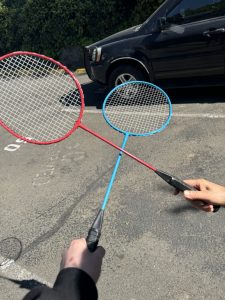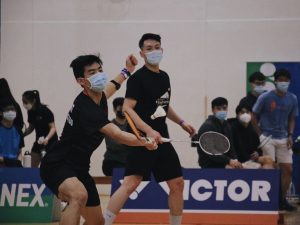University of Washington Badminton: Improving Student Fitness, Broadens Their Extracurricular Life
EDUC 200 Student, Roujia Wang, Zili Lin, Shangran Peng
From Zili Lin
The chapter From High School To College tells sports play an important role in helping students navigate the transition from high school to college by providing a welcoming community. (1) In Zili Lin’s interview, his interviewee H shares his story with UW badminton. He played badminton here at UW before his first academic quarter as a freshman, and he met many players from diverse backgrounds with a passion for badminton. Their friendship extends beyond the badminton fields; they registered for the same course and became classmates, group project teammates, and so on! Undoubtedly, for H, badminton helps bridge his high school life and college life smoothly.
License: CC BY-NC
From Roujia Wang
I interviewed Peng, a fellow student passionate about the sport. She shared, “Badminton isn’t just about the game; it’s about building connections. Peng detailed how badminton offers a relief from academic stress and a chance to form meaningful friendships. “Playing doubles, especially, strengthens bonds as we rely on each other’s strengths,” she noted. This exemplifies the collegiate ideal of fostering personal growth and community through sports.
Badminton at our university isn’t just a sport; it’s a crucial part of how students interact and support each other, enhancing both their physical well-being and social lives.
“Every match is more than just play; it’s a shared experience that brings us together,” Peng explained, highlighting the sport’s role in creating a supportive community. This narrative aligns with the course theme of the collegiate ideal, showing how sports like badminton contribute significantly to the university experience by promoting community and personal development.
License: CC BY-NC
From Yuqi Liu
Through interviews with badminton enthusiasts, I realized that badminton is more than just a way for people to relax. It is a sport that better reflects the importance of sports in schools, and students can deepen their sense of belonging to the campus through badminton. Because playing badminton gathers many students who share the same hobby, they make new friends in the court and enhance their relationship through playing badminton. This kind of competitive sport can also cultivate students’ teamwork spirit, which is a manifestation of thick institutions. ‘Thick institutions’ are defined as organizations in the midst of rich traditions, strong values and a culture of being everywhere, a culture that profoundly influences the identities and behaviors of its members. The college’s emphasis on sports has brought a lot of benefits to students who share a common interest in sports.
License: CC BY-NC
From Shangran Peng
Through my interview with my friend Lu, I learned more about the importance of badminton and extracurricular sports for college students. These activities can provide a richer college life and reduce academic stress, resulting in a better overall college experience. During the pandemic, the school closed the classrooms and started distance learning, which made her feel very lonely and stressed. However, playing badminton allowed her to reconnect with her friends and meet new people. It also helped her reduce the stress of studying for midterms, finals, and other exams. Her experience showed me that badminton is not only a sport but also a way to reconnect with friends and the university community.
License: CC BY-NC

Photo credit: by Shangran Peng
License: CC BY-NC

Photo credit: instagram-huskcy.badminton
License: CC BY-NC
ChatGPT Disclaimer:
We use Chat GPT for grammar checking, and sentence completion. Our story ideas are our own.
References:
1. Students in The Place of Sports In The University. (2022, June 10). From high school to college. Pressbooks. https://uw.pressbooks.pub/theplaceofsports/chapter/club-campus-community/
2.Brooks, D. (2017, April 18). How to leave a mark on people. The New York Times. https://www.nytimes.com/2017/04/18/opinion/how-to-leave-a-mark-on-people.html.
(from class)
3. Gougian, P. (2017, June 14). Thick institutions. Epstein Hillel School. https://epsteinhillel.org/ha-ikar/thick-institutions/
4. Toma, J. D. (Ed.). (Year). Reconceptualizing the Collegiate Ideal: New Directions for Higher Education (J-B HE Single Issue Higher Education) (No. 105). Jossey-Bass.
(from class)
Media Attributions
- UW’s Badminton Club members

